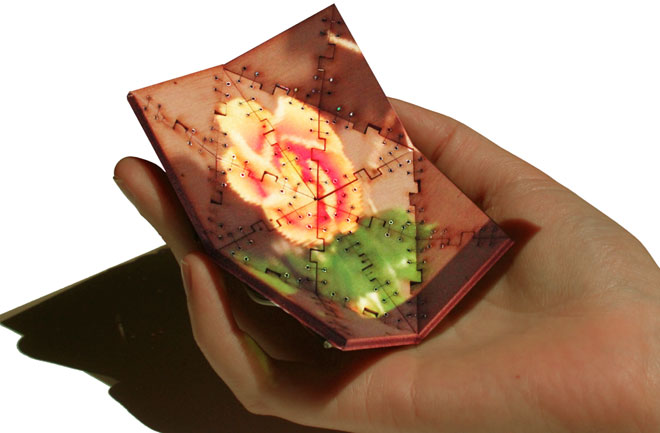 Imagine a cellphone that bends to block a snooping bystander from reading your private messages! Researchers, including an Indian origin scientist, have developed prototypes for gen-next shape-shifting smartphones and mobile devices that can change form on-demand.
The research introduces the term ‘shape resolution’ and its ten features, to describe the resolution of an interactive device, in addition to display and touch resolution.
The research, led by Dr Anne Roudaut and Professor Sriram Subramanian, from the University of Bristol’s Department ofComputer Science, have used ‘shape resolution’ to compare the resolution of six prototypes the team have built using the latest technologies in shape changing material, such as shape memory alloy and electro active polymer.
Six new prototypes for shape-shifting smartphones and mobile devices were recently unveiled, along with a method for classifying such devices as they make their way from research labs to the consumer marketplace.
Led by researchers from the University of Bristol’s Department of Computer Science, a team of computer scientists presented a series of so-called “Morphees” they believe could help create Transformer-like mobile devices of the future.
“Morphees are the future generation of flexible mobile devices,” lead researcher Anne Roudaut told Discovery News. “These are mobile devices that can change their shape on their own.
Roudaut envisions future users downloading games embedded with form factors that curl the edges of thin, mobile devices inward to resemble a game console shape, with the curved sides doubling as triggers for shooting games. Additionally, Roudaut sees the edges of Morphees bending to protect screen content or passwords and touch screens that take the shape of its displayed object.
The prototypes were made out of a range of materials like plastic, paper and wood, along with shape-changing materials and shape-memory alloys.
One prototype consisted of a plastic sheet sandwiched between two electrode layers. When voltage was applied to the electrodes, electrostatic forces squeezed the sheet, causing it to expand like a future touchscreen might do. Shape-memory alloys are special malleable metals that return to their original shape after being heated. These metals were primarily used as wires on the underside of four prototype displays. Passing an electric current through them caused them bend, thus contorting the display ‘surface.’
Another prototype used small motors connected to guitar strings affixed to a plastic sheet. When a motor turned in one direction, it bent the display surface. Another prototype used interlocking, heat-resistant wood tiles stitched together with SMA wire. Researchers connected the wires to a transistor and an Arduino board to give the prototype three bendable functions.
While these crude materials merely mimicked flexible glass or plastic touchscreens, their main function was to support the shape-shifting materials, and provide researchers with potential concepts for future applications.
By comparing the shape resolution of their prototypes, the researchers have created insights to help designers towards creating high shape resolution Morphees.
In future, the team hopes to build higher shape resolution Morphees by investigating the flexibility of materials. They are also interested in exploring other kinds of deformations that the prototypes did not explore, such as porosity and stretchability.
Photo Courtesy: University of Bristol, Department of Computer Science
Imagine a cellphone that bends to block a snooping bystander from reading your private messages! Researchers, including an Indian origin scientist, have developed prototypes for gen-next shape-shifting smartphones and mobile devices that can change form on-demand.
The research introduces the term ‘shape resolution’ and its ten features, to describe the resolution of an interactive device, in addition to display and touch resolution.
The research, led by Dr Anne Roudaut and Professor Sriram Subramanian, from the University of Bristol’s Department ofComputer Science, have used ‘shape resolution’ to compare the resolution of six prototypes the team have built using the latest technologies in shape changing material, such as shape memory alloy and electro active polymer.
Six new prototypes for shape-shifting smartphones and mobile devices were recently unveiled, along with a method for classifying such devices as they make their way from research labs to the consumer marketplace.
Led by researchers from the University of Bristol’s Department of Computer Science, a team of computer scientists presented a series of so-called “Morphees” they believe could help create Transformer-like mobile devices of the future.
“Morphees are the future generation of flexible mobile devices,” lead researcher Anne Roudaut told Discovery News. “These are mobile devices that can change their shape on their own.
Roudaut envisions future users downloading games embedded with form factors that curl the edges of thin, mobile devices inward to resemble a game console shape, with the curved sides doubling as triggers for shooting games. Additionally, Roudaut sees the edges of Morphees bending to protect screen content or passwords and touch screens that take the shape of its displayed object.
The prototypes were made out of a range of materials like plastic, paper and wood, along with shape-changing materials and shape-memory alloys.
One prototype consisted of a plastic sheet sandwiched between two electrode layers. When voltage was applied to the electrodes, electrostatic forces squeezed the sheet, causing it to expand like a future touchscreen might do. Shape-memory alloys are special malleable metals that return to their original shape after being heated. These metals were primarily used as wires on the underside of four prototype displays. Passing an electric current through them caused them bend, thus contorting the display ‘surface.’
Another prototype used small motors connected to guitar strings affixed to a plastic sheet. When a motor turned in one direction, it bent the display surface. Another prototype used interlocking, heat-resistant wood tiles stitched together with SMA wire. Researchers connected the wires to a transistor and an Arduino board to give the prototype three bendable functions.
While these crude materials merely mimicked flexible glass or plastic touchscreens, their main function was to support the shape-shifting materials, and provide researchers with potential concepts for future applications.
By comparing the shape resolution of their prototypes, the researchers have created insights to help designers towards creating high shape resolution Morphees.
In future, the team hopes to build higher shape resolution Morphees by investigating the flexibility of materials. They are also interested in exploring other kinds of deformations that the prototypes did not explore, such as porosity and stretchability.
Photo Courtesy: University of Bristol, Department of Computer Science
2 mins read
Smartphones changing shapes to fit function soon a reality
 Imagine a cellphone that bends to block a snooping bystander from reading your private messages! Researchers, including an Indian origin scientist, have developed prototypes for gen-next shape-shifting smartphones and mobile devices that can change form on-demand.
The research introduces the term ‘shape resolution’ and its ten features, to describe the resolution of an interactive device, in addition to display and touch resolution.
The research, led by Dr Anne Roudaut and Professor Sriram Subramanian, from the University of Bristol’s Department ofComputer Science, have used ‘shape resolution’ to compare the resolution of six prototypes the team have built using the latest technologies in shape changing material, such as shape memory alloy and electro active polymer.
Six new prototypes for shape-shifting smartphones and mobile devices were recently unveiled, along with a method for classifying such devices as they make their way from research labs to the consumer marketplace.
Led by researchers from the University of Bristol’s Department of Computer Science, a team of computer scientists presented a series of so-called “Morphees” they believe could help create Transformer-like mobile devices of the future.
“Morphees are the future generation of flexible mobile devices,” lead researcher Anne Roudaut told Discovery News. “These are mobile devices that can change their shape on their own.
Roudaut envisions future users downloading games embedded with form factors that curl the edges of thin, mobile devices inward to resemble a game console shape, with the curved sides doubling as triggers for shooting games. Additionally, Roudaut sees the edges of Morphees bending to protect screen content or passwords and touch screens that take the shape of its displayed object.
The prototypes were made out of a range of materials like plastic, paper and wood, along with shape-changing materials and shape-memory alloys.
One prototype consisted of a plastic sheet sandwiched between two electrode layers. When voltage was applied to the electrodes, electrostatic forces squeezed the sheet, causing it to expand like a future touchscreen might do. Shape-memory alloys are special malleable metals that return to their original shape after being heated. These metals were primarily used as wires on the underside of four prototype displays. Passing an electric current through them caused them bend, thus contorting the display ‘surface.’
Another prototype used small motors connected to guitar strings affixed to a plastic sheet. When a motor turned in one direction, it bent the display surface. Another prototype used interlocking, heat-resistant wood tiles stitched together with SMA wire. Researchers connected the wires to a transistor and an Arduino board to give the prototype three bendable functions.
While these crude materials merely mimicked flexible glass or plastic touchscreens, their main function was to support the shape-shifting materials, and provide researchers with potential concepts for future applications.
By comparing the shape resolution of their prototypes, the researchers have created insights to help designers towards creating high shape resolution Morphees.
In future, the team hopes to build higher shape resolution Morphees by investigating the flexibility of materials. They are also interested in exploring other kinds of deformations that the prototypes did not explore, such as porosity and stretchability.
Photo Courtesy: University of Bristol, Department of Computer Science
Imagine a cellphone that bends to block a snooping bystander from reading your private messages! Researchers, including an Indian origin scientist, have developed prototypes for gen-next shape-shifting smartphones and mobile devices that can change form on-demand.
The research introduces the term ‘shape resolution’ and its ten features, to describe the resolution of an interactive device, in addition to display and touch resolution.
The research, led by Dr Anne Roudaut and Professor Sriram Subramanian, from the University of Bristol’s Department ofComputer Science, have used ‘shape resolution’ to compare the resolution of six prototypes the team have built using the latest technologies in shape changing material, such as shape memory alloy and electro active polymer.
Six new prototypes for shape-shifting smartphones and mobile devices were recently unveiled, along with a method for classifying such devices as they make their way from research labs to the consumer marketplace.
Led by researchers from the University of Bristol’s Department of Computer Science, a team of computer scientists presented a series of so-called “Morphees” they believe could help create Transformer-like mobile devices of the future.
“Morphees are the future generation of flexible mobile devices,” lead researcher Anne Roudaut told Discovery News. “These are mobile devices that can change their shape on their own.
Roudaut envisions future users downloading games embedded with form factors that curl the edges of thin, mobile devices inward to resemble a game console shape, with the curved sides doubling as triggers for shooting games. Additionally, Roudaut sees the edges of Morphees bending to protect screen content or passwords and touch screens that take the shape of its displayed object.
The prototypes were made out of a range of materials like plastic, paper and wood, along with shape-changing materials and shape-memory alloys.
One prototype consisted of a plastic sheet sandwiched between two electrode layers. When voltage was applied to the electrodes, electrostatic forces squeezed the sheet, causing it to expand like a future touchscreen might do. Shape-memory alloys are special malleable metals that return to their original shape after being heated. These metals were primarily used as wires on the underside of four prototype displays. Passing an electric current through them caused them bend, thus contorting the display ‘surface.’
Another prototype used small motors connected to guitar strings affixed to a plastic sheet. When a motor turned in one direction, it bent the display surface. Another prototype used interlocking, heat-resistant wood tiles stitched together with SMA wire. Researchers connected the wires to a transistor and an Arduino board to give the prototype three bendable functions.
While these crude materials merely mimicked flexible glass or plastic touchscreens, their main function was to support the shape-shifting materials, and provide researchers with potential concepts for future applications.
By comparing the shape resolution of their prototypes, the researchers have created insights to help designers towards creating high shape resolution Morphees.
In future, the team hopes to build higher shape resolution Morphees by investigating the flexibility of materials. They are also interested in exploring other kinds of deformations that the prototypes did not explore, such as porosity and stretchability.
Photo Courtesy: University of Bristol, Department of Computer Science







